Are you a Quiet Speculation member?
If not, now is a perfect time to join up! Our powerful tools, breaking-news analysis, and exclusive Discord channel will make sure you stay up to date and ahead of the curve.
Happy New Year! At least, I'm assuming it's the new year. Hard to say; I'm typing this article from the bottom of what used to be a barrel of eggnog. Anyway, let's not let less-than-optimal writing conditions get in the way---it's Bloodbraid Month! Which is an excuse to hold off revealing the data from the banlist test at the end of the month. Before we get there, there's a lot of history and legwork to discuss. So find your seats and get comfortable: class is now in session.
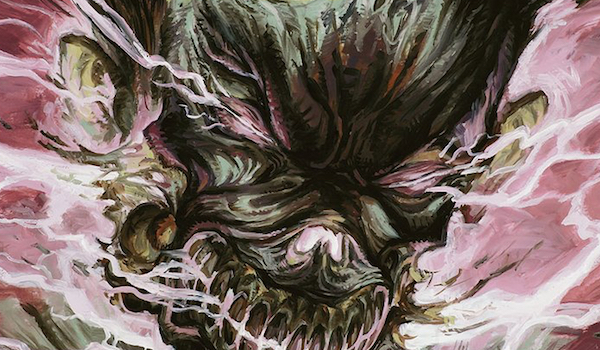
I have an unusual opportunity with this banlist test. Unlike the other cards, Bloodbraid Elf had a good run in Modern. Preordain doesn't count, as it only survived Modern's inauguration. Bloodbraid had roughly a year and a half, from the creation of Modern until February 2013. That's not long in the grand scheme of things, but it's still a lot of time to generate data. Of course, there are complications with this time period. It was Modern's infancy, and with that came a lot of teething bans and adjustments. What I intend to do is focus my inquiry to the relatively stable period before Deathrite Shaman was released. This focus will isolate Bloodbraid Elf's impact on Jund and allow me to investigate how good that Jund deck actually was.
Background
Modern was proposed at the end of May 2011 and formally established by mid-August, partially to create a non-rotating format that Wizards could unabashedly support, unlike Legacy. The other reason was that Extended had become dramatically unpopular thanks to rotation changes, Cawblade dominance, and a general lack of support from the top.
When Modern stepped in to fill void, nobody really knew what to expect. The 2011 Community Cup was the only guidance anyone had going into PT Philadelphia, which wasn't particularly helpful as Hypergenesis was the deck from that event. PT Philadelphia was one of the most broken Pro  Tours in history, with blistering combo strategies dominating the tournament. This was followed by Worlds, a tournament dominated by Zoo and Punishing Fire. This imbalance resulted in the densest cluster of bans in Magic history.
Tours in history, with blistering combo strategies dominating the tournament. This was followed by Worlds, a tournament dominated by Zoo and Punishing Fire. This imbalance resulted in the densest cluster of bans in Magic history.
2012 was far more stable, yielding only the unban of Valakut, the Molten Pinnacle in September. Of course, on October 5th, Return to Ravnica released, and with it came arguably the best creature in the game: Deathrite Shaman. The following period led to an incredible surge of Jund wins, prompting Wizards to ban Bloodbraid Elf at the end of January.
Many subsequently pointed to Deathrite as being the real problem with Jund, claiming Bloodbraid was unfairly blamed. Furthermore, it has been argued that Jund was declining in popularity prior to Return to Ravnica's release, and Deathrite boosted the deck's popularity so much it appeared like a problem. These are the claims that I will investigate today. To do so, I will focus on the event data from January to October 2012.
Ancient History
Bloodbraid Elf-powered Jund was the deck of its era. In fact, the only reason it didn't win Worlds that year is because of a quirk of the multi-format event that favored the otherwise unremarkable Naya Lightsaber deck. Naya deck was widely considered a worse Jund list at the time, as the subsequent year of Jund domination supported. 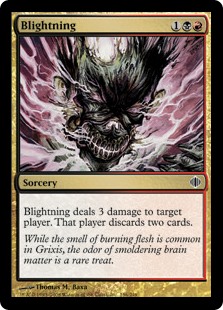 The deck technically won its Block Pro Tour, too. And even when it didn't win an event outright, it consistently still put up excellent numbers. A port of the Standard deck used to win in Extended during the Thopter Foundry/Dark Depths era; Bloodbraid-powered Jund was a multi-format all-star even pre-Modern.
The deck technically won its Block Pro Tour, too. And even when it didn't win an event outright, it consistently still put up excellent numbers. A port of the Standard deck used to win in Extended during the Thopter Foundry/Dark Depths era; Bloodbraid-powered Jund was a multi-format all-star even pre-Modern.
The power of Bloodbraid was always cascade. Getting to play and additional spell off the top of your deck is very good. The key was maximizing the good hits and minimizing misses, and Jund had the highest concentration of good cards at the time. Blightning was usually the best, and the reason that control struggled so hard in that era, but even Putrid Leech made for a solid rip. Elf provided a reliable two-for-one or better plus a tempo boost, outpacing every other deck.
Into Modern
It wasn't clear whether Jund's pre-Modern success would continue in this new format. Combo and Cloudpost were so prevalent early on that Jund struggled. If you think Tron is bad for midrange now, imagine Jund's 12-Post matchup. That said, a few Junds did sneak in. And once the bannings took effect, Jund began to rise, eventually peaking in popularity and power at the end of 2012.
Overall Data
Modern Nexus didn't exist back then, but MTGTop8 did, and they retain their aggregate data from that era. Their metagame data for the entire year (the only way to find it without going through the entire list yourself) shows Jund sitting firmly at the top of Tier 1 at 15%, followed distantly by Affinity (11%), Birthing Pod (9%), Tron (7%), and Twin (6%). Of course, this data does include results with Deathrite legal, but only for two and a half months of the year displayed. Deathrite Shaman doesn't appear until the middle result on page 6 of 14, and there are a page and a half 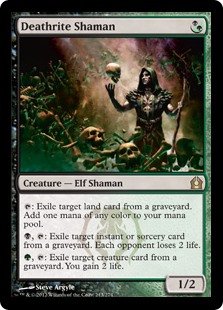 of results just from PT Return to Ravnica. That means that out of 13.5 pages of non-Pro Tour results, 7.5 house only Bloodbraid Jund. Even if you don't remove the PT, those results are more than Tron's total for the entire year. Simply put, Jund was Tier 1 independent of Deathrite Shaman.
of results just from PT Return to Ravnica. That means that out of 13.5 pages of non-Pro Tour results, 7.5 house only Bloodbraid Jund. Even if you don't remove the PT, those results are more than Tron's total for the entire year. Simply put, Jund was Tier 1 independent of Deathrite Shaman.
The PT results for Affinity begin on page 3 of 10, leaving roughly 7.5 pages of results before the PT, as with Jund. It is reasonable to argue that Jund and Affinity kept pace with each other for the top spot in Modern at that point. Birthing Pod has 6.5 pages of pre-PT results, so it was behind, but close; a solid third. All the other decks were well behind this pace on October 21, 2012, so they were never going to compete for the top slot. Deathrite indeed provided a massive power boost to Jund, but the deck didn't really need it to keep the crown.
Thought Experiment
Consider this hypothetical: if Deathrite Shaman had not existed, what might Modern have 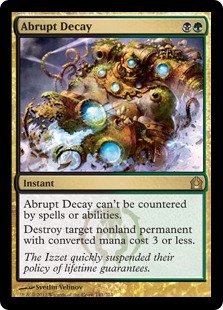 looked like at the end of 2012? I'd argue that it would have looked nearly the same as it actually did. Jund would have held a metagame share similar to Affinity's, above other challengers. Remember: Jund's most significant non-Deathrite card from Return was Abrupt Decay. Decay was a fine removal spell, but it was always limited and only truly great against Splinter Twin decks. The flexibility was nice against Affinity and Pyromancer Ascension decks, but it doesn't substantially impact those matchups for Jund even today.
looked like at the end of 2012? I'd argue that it would have looked nearly the same as it actually did. Jund would have held a metagame share similar to Affinity's, above other challengers. Remember: Jund's most significant non-Deathrite card from Return was Abrupt Decay. Decay was a fine removal spell, but it was always limited and only truly great against Splinter Twin decks. The flexibility was nice against Affinity and Pyromancer Ascension decks, but it doesn't substantially impact those matchups for Jund even today.
The data show that Jund took off after Return, but there is no reason to think that it would not have kept pace with the other established decks without Deathrite. No other deck received a noticeable boost from Return. Jace, Architect of Thought would be great in Twin eventually, but it took a while to be adopted.
By Events
This is a solid result, but it does rely on my interpretation of the MTGTop8 data. Therefore, I will build a separate data set based on the paper results. As far as I can tell, Star City did not support Modern in 2012; just Standard and Legacy. Therefore I will use the results from WoTC's official coverage for pre-Return to Ravnica Modern. This is composed of four Grand Prix, the Magic Cup, and the Player's Championship. I'm separating out the Player's Championship from the rest of the results because they are very weird and would skew the data. Aggregating the Top 8 decklists (which are the only ones available for the most part) yields this result:
Jund had the most paper Top 8's prior to October 2012. Not by much, perhaps, but the deck was still solidly Tier 1. At least one Jund deck was in every Top 8, with the earlier tournaments having multiple. Jund had a solid steady presence before Return, contrary to claims of Jund's decline.
The Player's Championship, being an invitational tournament, had a very weird metagame. Therefore I'm going to treat it separately. The table should make why clear.
As you can see, Zoo was inordinately popular here. It shows up nowhere else, and including these results with the rest would have distorted the metagame. It makes Zoo look like a good deck, and it wasn't. That said, Jund was the second most popular deck and arguably the best. Yuuya Wantanabe won with Jund, only losing one match the whole weekend. Bloodbraid Elf was also the coverage team's #1 card of the tournament, for whatever that's worth. In both the Deck Tech videos and conversation surrounding the event, players were singing Elf's praises, pointing to it as the glue and soul of the deck. Its intrinsic two-for-one and tempo boost was as good in Modern as it had been in Standard.
Consequences
It is worth noting that the Player's Champtionship was the last paper Modern event before Return arrived. Jund had not merely won; Yuuya dominated with the deck. In fact, we see a large spike in Jund results following that tournament. Before August, MTGO Daily results for Jund are rare. There are eight Daily/Premier results prior to August, eight in August, and 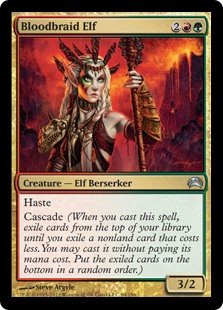 36 in September. In other words, in August there were as many Jund decks reported from MTGO Daily's as in the rest of the year combined, and 4.5 times that amount in September. That is a significant and rapid increase going into the Pro Tour.
36 in September. In other words, in August there were as many Jund decks reported from MTGO Daily's as in the rest of the year combined, and 4.5 times that amount in September. That is a significant and rapid increase going into the Pro Tour.
The claim that Jund was declining in popularity before Return is therefore suspect at best, and more likely outright false. The data show clearly that Jund was in fact becoming more successful online and was preforming highly in paper prior to October 2012. Why this surge happened when it did is hard to say. Maybe it was just Pro Tour testing. Perhaps players were just waiting for a break-out performance to pick up the deck. Maybe it was a lack of confidence in Modern as a whole that resolved itself over the course of 2012. Regardless, the bottom line is that Jund was more popular and successful in September than at any point in the earlier data.
Conclusion
It is impossible to say with certainty that Bloodbraid Elf would still have been banned without Deathrite Shaman's printing. However, the data show that Jund was a very strong and successful deck without Shaman. Its popularity and success was increasing prior to the explosion in October, and the trend of Jund winning paper events began in August---a trend which was specifically cited in the banning announcement.
Therefore, in my analysis, the claim that Bloodbraid Elf was only banned because of Deathrite Shaman should be considered suspect. There is evidence and data to show that it was powerful enough to propel the deck to Tier 1 without the one-mana planeswalker's help.
I believe that Jund would have been the top deck in Modern even without Deathrite Shaman. Whether it could maintain its position is hard to say. Dragon's Maze would bring Voice of Resurgence, among other cards, which would prove critical to the Birthing Pod value plan that eventually led to that deck's banning. Maybe Jund would have naturally fallen off; maybe it would have maintained or expanded its position. Who knows? What's unequivocal is that Jund was already a top deck when it was boosted by Deathrite Shaman. Therefore, given Wizards's old bad habit of banning the best decks prior to the Pro Tour, I think that Bloodbraid would have been banned eventually anyway. At most, Deathrite accelerated the timeframe.
Next week, I'll describe the struggle to actually test the elf. Until then, does anyone have suggestions for getting unwedged from the bottom of an eggnog barrel?




